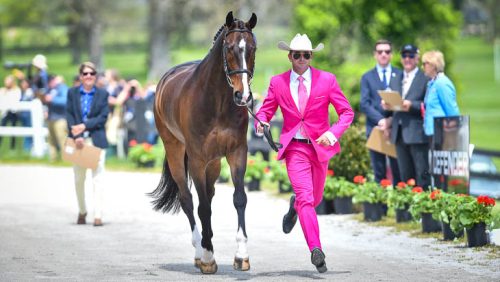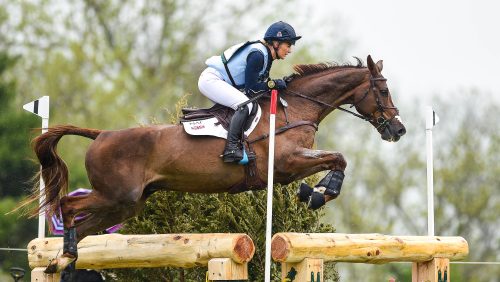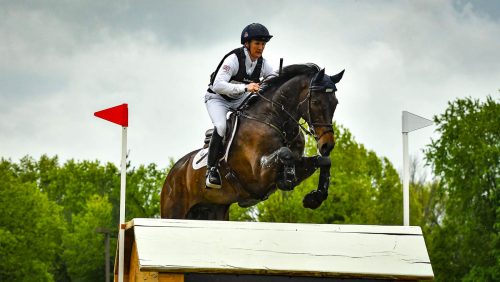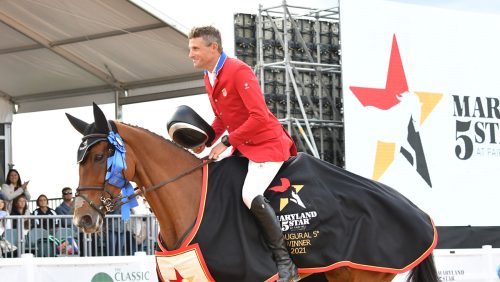When you’re walking a course and the rails are above your boobs, you may start to question some life choices. But I finally did it—I competed in some big classes and I didn’t vomit or fall off.
In fact, I laid down respectable rounds. And I learned a few things. For starters: once the jumps get above 1.20-meter, they’re just big. The difference between 1.0-meter and 1.10-meter seems much vaster than the difference between 1.20-meter and 1.30-meter. And then you really start having crazy thoughts that the 1.40-meter doesn’t seem so huge after all.
But that all depends on what you’re sitting on and I had the incredible privilege to ride a not only capable but also exceptionally kind horse. I’ve never ridden a horse that knows and likes her job more than Fiona.
I am so appreciative of all the people who made this adventure possible. I owe so much to my friend Bree Rosales who knew my ride better than I did and matched me with Fiona. Bree has been my best cheerleader over the last couple years; her positivity and encouragement have completely changed my mental game in the show ring. At the beginning of my time in Florida she asked me what my plan was. I gave some wishy washy answer about doing some 1.10-meter and 1.15-meter classes the first week and then finishing in the 1.20-meter the second week.
She said, “I think you should go for it. Do the 1.20-meter the first week then move up to the 1.30-meter the second week. That’s the whole reason you’re here.”
And she was right. Wasn’t breaking through the 1.20-meter ceiling the whole point of leasing Fiona and making this great migration south? But I needed to hear those words from someone else. Sometimes, I think we’re afraid articulate our most important goals; because it opens the door for failure. If I never say what I want out loud; then no one can ever know I didn’t achieve it.
But there’s something about stating your goals that is equally empowering as it is intimidating. It creates an invisible force to propel you in the direction of your dreams.
And maybe I’m getting older or wiser or maybe the events of the last year have changed me in ways I don’t fully understand just yet. Nothing is really that big of a deal to me anymore.
ADVERTISEMENT
In years past I had so many thoughts, worries and fears circulating around my brain at the in-gate: “What if I eat Fence 1?” “What if I forget where I’m going?” “What if I screw up and people see it and say nasty things about my riding?” “What if I fall off and get hurt?” “What if I embarrass myself?”
A funny thing happened in Ocala—I let all that go and said “So what?”
The reality is, no one cares all that much what someone else does in the ring. Yeah, I’ve seen people have a bad trip or two but I rarely remember who they were or what horse they were riding. I just don’t have the time to think negative thoughts about other riders and when I came to that realization, I started to think that they probably didn’t have the time to think negative thoughts about me either.
We’ve all missed. We’ve all gone off course. We are our own harshest critics in those moments because the nature of those failures is so personal. The reality is that we have to be obsessed with our own riding and our own horses to be successful. The minute we start to waste our energy on what someone else is doing we lose focus and make mistakes.
I got a great piece of advice in a lesson with Joe a while back. I had an awkward distance and had a rail. I was mortified. It never feels good to have a chocolate-chipper in front of an Olympian, and as I was going around he said something like, “Forgot about that one, it’s behind you. You lived. Now keep riding to the next fence and don’t make the same mistake.” Getting permission to let go of a mistake, to keep riding because there are more fences to be jumped was profound.
As obvious as it might seem now, this was the first time that anyone had spared me from the emotional shame spiral of negativity that always followed a mistake. Because how else are we going to learn? How many times have I told my students to let the horse make a mistake, have I pushed them to try new exercises that I knew they wouldn’t get right the first time? That’s how we learn to ride.
And yes, in the show ring you do want everything to go right, but we’re riding horses, not bicycles. They’re animals, not machines and we cannot expect perfection from them any more than we can expect it from ourselves. When I stopped looking at shows as this grand crescendo of everything I’ve ever learned and stopped being afraid of making mistakes in the public eye, I made fewer of them.
I am glad that I am riding Fiona now and not a few years ago. I always felt like if I could just get the right horse I would shoot up the levels and be be-bopping around grand prixs in no time. But before now, I wasn’t mentally ready to move up the levels.
ADVERTISEMENT
I knew that I needed to sharpen my mental game, and I could coach others to do it, but executing it myself was still a challenge. In Ocala, I finally felt what everyone had been trying to get me to feel for years: calm. My husband, Andy kept saying how I looked so “Zen” when I walked in the ring. When I came out he said, “I’ve never seen you jump a course of jumps that big before and you just did it like it was nothing.”
I was ready. I wasn’t afraid. I trusted my horse.
This horse has changed my career. Before this trip I had sometimes questioned whether pursuing the upper levels was really what I was meant to do. I have a thriving business. I enjoy working with young horses, sales and teaching. I don’t need to jump a grand prix to earn a good living.
But there’s more to life than earning a good living. There are many other manure-free jobs I could do if I just wanted to make enough money to pay my bills. Fiona has changed the trajectory; she makes what seemed like a distant impossible dream a goal within reach.
I want to thank Gail Dady for entrusting me with the best big white horse in the whole world. There really aren’t words to express my appreciation for her kindness and generosity. Without Gail and the whole Caliburn Farm team none of this would have been possible.
A big thanks goes out to all my friends who held down the fort during the biggest blizzard we’ve seen in years and to my loyal customers and boarders who supported my Florida adventure. Thanks also to my sponsors, Antares Sellier and Equine Omega Complete for their continued support. It takes a village and I’ve certainly got a good one.
Chronicle blogger and up and coming hunter/jumper trainer Paige Cade spent most of the 2015 FTI Winter Equestrian Festival working for Margie Engle’s Gladewinds Farm, and has recently made the decision to return to Virginia to start her own riding and training business, Country Fox Farm, Inc. Paige would like to thank Antares, Equine Omega Complete, Dr. Sallie Hyman and Total Equine Veterinary Associates for their continued support for the 2016 season. Read all her blog entries.















